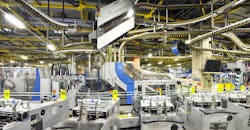The 5 Types of Manufacturing Processes
It may be surprising to learn that many engineers with great talent and a depth of experience have a hard time answering questions about the type(s) of manufacturing environments that exist in their company.
Most manufacturing environments fit into one of five general categories. Repetitive, Discrete, Job Shop, Process (batch), and Process (continuous).
Most companies use more than one of these environments to get a single product out the door. This is certainly true considering today's use of the supply base versus the historical practices of vertically integrated companies. Vertically integrated companies often had all five environments.
Here’s a closer look at the five environments:
Repetitive: This category, with some exceptions, is best described as having dedicated production lines that turn out the same item, or a closely related family, 24/7 all year long. Speeding up or slowing down the speed of the operation modulates differences in customer demand. There is little setup and changeover activity. If the peak line speed cannot keep up with demand, a second line is added. If demand is not enough for a dedicated second line, it is met by a second line operating in Discrete mode that also makes other products.
Discrete: This environment is highly diverse. It covers a range from few setups and changeovers to frequent setups and changeovers. The products being made may be alike or highly disparate. The more unlike the products are, the longer is the unproductive set-up and tear-down time.
Job Shop: Job shops rarely have production lines, they have production areas. The area may assemble only one version of a product, a dozen versions, or even a couple dozen. If demand grows, the operation is turned into a discrete line and selected labor operations are replaced by automated equipment.
These three environments, taken together, are a continuum for mechanical, electromechanical, electronic, and software-driven hardware products. At one end, manufacturing is continuous. At the other end, it is highly intermittent. Designers at the continuous end must be versed not only in the product’s design, but also the design of the process equipment. The more repetitive production is, the more likely the environment is dominated automated equipment. Production personnel rarely touch the product; their role is to oversee the equipment and assure it functions properly.
Designers at the Discrete end, with Job Shop being the ultimate case of Discrete, must be versed in product design and know when to involve equipment instead of labor for production. Designers in Job Shop environments generally cannot justify automated production equipment and must be expert in parsing the design so that components and subassemblies are made or acquired economically. They must also be expert in understanding how their design can be manually assembled.
The remaining two environments have many analogies to those just described. The primary difference is that scientists and chemical engineers typically "design" the product, and the process equipment is handled by engineers versed in repetitive and/or discrete design. The product is usually described by a formula plus a bill of materials.
Process (continuous): These operations are analogous to Repetitive; they run 24/7 all the time. The primary difference is that production materials are gases, liquids, powders, or slurries. In some cases, such as mining, they can be granular or chunky materials. Design considerations are analogous, except the disciplines to create final product and production process are more diverse.
Process (batch): Batch-process operations are analogous to Discrete and Job Shop. Sometimes one batch is all it takes to meet demand. Sometimes it takes several batches. The equipment is then cleaned and the next product run. In some cases, Batch processes can be continuous in nature, making one batch after another of the same product. This is common when the composition of raw materials cannot be made to a strict standard. Each batch must be analyzed and some change made to the original formulation to turn out a final product that meets the spec. Again, design considerations are analogous and the disciplines are more diverse.
See the 5 Types graphic upgraded to the 6 Types graphic in my MD Sept 2018 column.
About the Author
Bradford Goldense
Contributing Technical Expert
Bradford L. Goldense is founder and president of Goldense Group, Inc. [GGI] (www.goldensegroupinc.com), a consulting, market research, and education firm focused on business and technology management strategies and practices for product creation, development, and commercialization. He has been an adjunct faculty member of the graduate engineering school at Tufts University's Gordon Institute for 19 years. Goldense is a Certified New Product Development Professional [NPDP], a Certified Manufacturing Engineer [CMfgE], a Certified Computer Professional [CCP], and is Certified In Production & Inventory Management [CPIM]. He holds over 200 registered copyrights and is a recognized subject-matter expert, including appearances on PBS and CNBC. He has consulted to over 250 companies and over 750 manufacturing locations on four continents since founding GGI in 1986. Goldense holds an MBA in Accounting from the Cornell Johnson School and a BSCE from Brown University. For more information, please see Brad's LinkedIn profile or visit GGI's home page.


